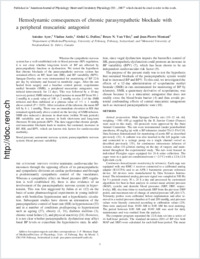Hemodynamic consequences of chronic parasympathetic blockade with a peripheral muscarinic antagonist
- Ayer, Antoine Department of Medicine/Physiology, University of Fribourg, Switzerland
- Antic, Vladan Department of Medicine/Physiology, University of Fribourg, Switzerland
- Dulloo, Abdul G. Department of Medicine/Physiology, University of Fribourg, Switzerland
- Vliet, Bruce N. Van Memorial University of Newfoundland, St. John's, Canada
- Montani, Jean-Pierre Department of Medicine/Physiology, University of Fribourg, Switzerland
-
11.05.2007
Published in:
- American Journal of Physiology: Heart and Circulatory Physiology. - 2007, vol. 293, p. H1265-H1272
English
hereas the sympathetic nervous system has a well-established role in blood pressure (BP) regulation, it is not clear whether long-term levels of BP are affected by parasympathetic function or dysfunction. We tested the hypothesis that chronic blockade of the parasympathetic nervous system has sustained effects on BP, heart rate (HR), and BP variability (BPV). Sprague-Dawley rats were instrumented for monitoring of BP 22-h per day by telemetry and housed in metabolic cages. After the rats healed from surgery and a baseline control period, scopolamine methyl bromide (SMB), a peripheral muscarinic antagonist, was infused intravenously for 12 days. This was followed by a 10-day recovery period. SMB induced a rapid increase in mean BP from 98 ± 2 mmHg to a peak value of 108 ± 2 mmHg on day 2 of the SMB infusion and then stabilized at a plateau value of +3 ± 1 mmHg above control (P < 0.05). After cessation of the infusion, the mean BP fell by 6 ± 1 mmHg. There was an immediate elevation in HR that remained significantly above control on the last day of SMB infusion. SMB also induced a decrease in short-term (within 30-min periods) HR variability and an increase in both short-term and long-term (between 30-min periods) BPV. The data suggest that chronic peripheral muscarinic blockade leads to modest, but sustained, increases in BP, HR, and BPV, which are known risk factors for cardiovascular morbidity.
- Faculty
- Faculté des sciences et de médecine
- Department
- Département de Médecine
- Language
-
- English
- Classification
- Biological sciences
- License
-
License undefined
- Identifiers
-
- RERO DOC 8673
- DOI 10.1152/ajpheart.00326.2007
- Persistent URL
- https://folia.unifr.ch/unifr/documents/300566
Statistics
Document views: 154
File downloads:
- pdf: 132
